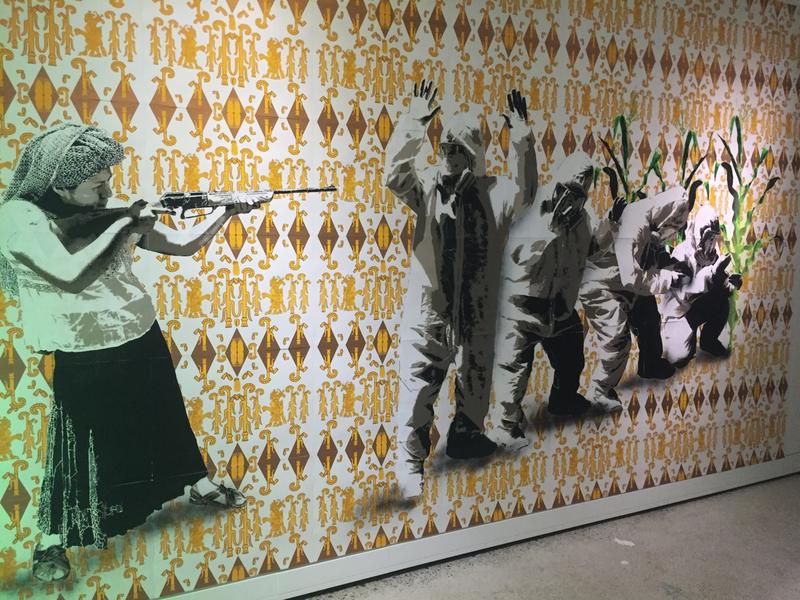Arts of Resistance: Politics and the Past in Latin America, an exhibit currently showcased at the Museum of Anthropology at the University of British Columbia, depicts the continuous struggles of Latin American Indigenous communities. Through art, people are able to find a voice to speak out against the mistreatment and injustice committed against them.

Maize, also known as corn, is a staple food among most people in Latin America. It is a source of nutrition for many people and their livestock, as well as a source of income and industrial fuel. This staple product “provides at least 30 percent of the food calories of more than 4.5 billion people in 94 developing countries.” (CYMMYT) The dependence on maize is unsustainable in such an increasingly globalized world economy. Especially for rural farmers whose livelihoods depend on the production of traditionally grown maize, as the cultivation of genetically modified maize tremendously impacts the local markets of the Indigenous people.
The exhibition demonstrates the growing tensions between tradition and modernization in the political landscape. The local people use modern art to show their unrest through silent protest. Political graffiti is a recent phenomena, drawing silent attention to the political views of the artist. Often stencils are used to portray the image various times, affecting more people. In this illustration, the background is a yellow canvas, with a “pre-Hispanic symbol for maize and the pre-Hispanic Central Mexica maize goddess Centeotl.” (Art of Resistance) The graffiti on the wall shows an Indigenous woman holding a rifle to the creators of genetically modified maize. This depiction connects the persistent defence of Indigenous tradition against the contemporary political realities. The Indigenous people have been directly affected by the selling of cheaper crops, therefore unable to produce and flourish off the land as they had for hundreds of years beforehand.
In sociology, we discuss how the structures of nation can create cohesion within a society. Durkheim theorizes that religion binds a community through a sense of ritualistic or traditional obligation, creating solidarity within. Although maize does not hold explicit religious meaning, the concept of religious tradition, still pertains to the long-standing history the Indigenous people bear with maize. When policies were put into place, and the “commercial appropriation of Indigenous culture and for non-Indigenous profit,” (Art of Resistance) was established, both ancestral culture and the Indigenous sense of society were challenged. Due to this, the Indigenous people of Mexico fiercely defended their way of life.
Similar to this, the Indigenous people of Canada also fiercely defend their traditions when modernization threatens their culture. For example, the controversial Kinder Morgan Pipeline threatens the ancestral values and territories of the Indigenous peoples. They see the pipeline as an infringement of their Treaty Rights, as well as the emphasis on environmental stewardship and justice. (Roy) The great respect Indigenous groups have for their natural surroundings is deeply seeded within their culture due to the physical dependance and spiritual connection Indigenous groups have always felt towards their environment. The Indigenous peoples of Canada are enormously proud of their heritage, and fully embrace their time-honoured artwork, regalia, music and storytelling in order to remember their beginnings.
As the curator, Dr. Laura Osorio Sunnucks tells us, “this exhibition proves that creativity and arts and imagination are the ways that a lot of people who are disenfranchised do find healing, find strength and find solidarity.” (Gonzalez) This exhibit demonstrates that oppression causes an uproar of backlash, as a minority fights against the suppression of their liberty. This exhibit not only teaches us of the struggle that many societies face to maintain their culture, but it also demonstrates how deeply this persecution is felt. Suffering appears in art and music as a political statement, and eventually becomes apart of history. Fortunately for us, we can now examine these pieces as a movement towards justice, further allowing us to grow and expand as global citizens.
Works Cited
Art of Resistance. 17 May.-30 Sept. 2018, Museum of Anthropology at University of British Columbia, Vancouver.
CYMMYT. “Why MAIZE.” CGIAR Research Program on Maize, 2016, maize.org/why-maize/ Accessed Sept. 30, 2018.
Gonzalez, Brenda. “Arts of Resistance: Politics and the Past in Latin America showcases the social value of political art.” The Ubyssey, 30 May, 2018. https://www.ubyssey.ca/culture/arts-of-resistance-showcases-politics-in-art/ Accessed Sept. 30, 2018.
Green, Madeleynn. “A Beautiful Mess: The Evolution of Political Graffiti in the Contemporary City.” Inquiries Journal, 2014. http://www.inquiriesjournal.com/articles/1699/a-beautiful-mess-the-evolution-of-political-graffiti-in-the-contemporary-city Accessed Sept. 30, 2018.
Morris, M. L. Impacts of Maize Breeding Research in Latin America, 1966-1997. CIMMYT, 1999. Accessed Sept. 20, 2018.
Ranum, Peter, et al. “Global Maize Production, Utilization, and Consumption.” Annals of the New York Academy of Sciences, Wiley/Blackwell (10.1111), 20 Mar. 2014, nyaspubs.onlinelibrary.wiley.com/doi/full/10.1111/nyas.12396 Accessed Sept. 20, 2018.
Roy, Christopher. “Mission & Vision.” RAVEN, RAVEN – Respecting Aboriginal Values and Environmental Needs, 2009, raventrust.com/about/mission-vision/ Accessed Sept.30, 2018.